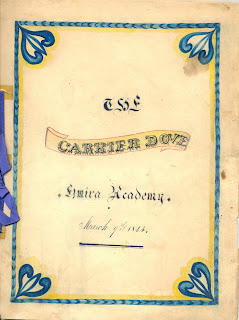Why is there a ‘free’ in Elmira Free Academy? The short answer is because students could attend for free, but the longer answer is much more interesting. Settle in for the exciting history of education in early America!
The earliest schools
in America were not public schools; they were private ‘dame’ schools. These
dame schools were run by educated women (often widowed or unmarried) and hosted
within their homes. The curriculum focused on the basics of reading, writing,
and arithmetic. Even after public schools began appearing in the late 1790s,
dame schools remained popular. As late as the 1840s, there were dozens of dame
schools in Elmira alone. Several even
lasted until the turn of the century. Some of the more famous area teachers
from this period include Eliza Hills, Miss Chalmers, Clarissa Thurston, and the
Cleves sisters.
In 1795, New York
State established a fund to support a system of common schools. By 1814, every
county in the state was home to dozens of tiny school districts with a one-room
school house funded by a mix of state aid and local property taxes. The problem
was that, like today, no one actually liked paying those property taxes and so
voters kept them really, really low. In
order to make up the difference between income and expenses, students were
charged tuition. This meant that poorer children could simply not afford to
attend school.
 |
| Old Time-y school house, ca. 1800 |
Both the dame schools
and the common schools taught only the basics. If you wanted to learn more, you
attended a private ‘academy’ or ‘seminary’.
By the 1850s, there were 165 private academies throughout the
state. Elmira was home to the Elmira
Academy. The Academy was a boarding and
day school which accepted both male and female students from throughout the
Twin Tiers. Courses included English,
French, German, Greek, Latin, advanced mathematics, astronomy, botany, history,
geography, logic, rhetoric, surveying, book keeping, philosophy, chemistry,
agricultural chemistry, science of government, art, and music. Tuition ranged from $200 to $400 per term (depending
on course of study) with an additional $200 or so dollars for boarding.
Elmira’s best families educated their children there, but most couldn’t afford
it.
 |
| Elmira Academy student literary magazine, 1848 |
In 1859, voters in
the city of Elmira established the Elmira School District. It was a consolidation of 5 existing common
school districts and was the first in the county to offer a truly free public
education. At the time, there were 700
students enrolled in Elmira’s public schools, while 1,000 attended private
schools. The vast majority of school-age children didn’t attend school at all. In
addition to operating 5 grammar schools, the city also established Elmira Free
Academy as a cheaper (free!) alternative to the Elmira Academy. For the first time, Elmira’s working class
families could actually afford to give their kids a decent education!
 |
| Original EFA building, 1861 |
Wow, its incredible to know that we had so many different types of schools back in the day compared to what we know of today, I remember way back when I was in grade school visiting a one room school house in Montour Falls NY which still stands today, and how it was run
ReplyDeleteHow wonderful it must have been to find out that you could send your children to school for free. Teaching them to read would open the world up for them. Something we should reflect on today that this wasn't always available to us.
ReplyDeleteGreat history. Nice to know how thing like schools got started
ReplyDeleteI was told by my Father that when Elmira Academy became free, an aunt moved from the countryside to an area near the school, so related children, could move in with her and attend the school.
ReplyDelete